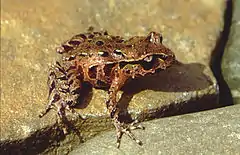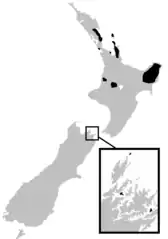| Leiopelmatidae[1] | |||||
| Mivart, 1869 | |||||
| Okres istnienia: 200–0 mln lat temu | |||||
 Przedstawiciel rodziny – liopelma Archeya (L. archeyi) | |||||
| Systematyka | |||||
| Domena | |||||
|---|---|---|---|---|---|
| Królestwo | |||||
| Typ | |||||
| Podtyp | |||||
| Gromada | |||||
| Rząd | |||||
| Podrząd |
Archebatrachia | ||||
| Rodzina |
liopelmowate | ||||
| Typ nomenklatoryczny | |||||
|
Leiopelma hochstetteri Fitzinger, 1861 | |||||
| |||||
| Rodzaje | |||||
|
| |||||
| Zasięg występowania | |||||
 | |||||
Liopelmowate[12] (Leiopelmatidae) – monotypowa rodzina płazów z rzędu bezogonowych (Anura). Ich względnie prosta budowa wskazuje na pradawne pochodzenie[13][14].
Zasięg występowania
Rodzaj obejmuje gatunki występujące na Nowej Zelandii[15].
Charakterystyka
Jaja składa w jednym kłębie pod różnymi przedmiotami w okolicy mokradeł, źródeł lub potoków (głazy, korzenie, zmurszałe pnie). Larwy nie mają aparatów gębowych i otworów oddechowych – tlen pobierają silnie ukrwioną siecią naczyń w fałdach ogona i na brzuchu, zaś żywią się zawartością żółtka. Dorosły osobnik ma ok. 3 cm (maksymalnie 5[16]), barwę żółtoszarą. Żyje w jamach, skalnych szczelinach, pod korzeniami krzewów, gdzie chroni się przed wiatrami. Prowadzi naziemny tryb życia. Długość życia tej jednej z najprymitywniejszych żab wynosi nawet 30 lat.
Systematyka
Taksonomia
Najbliższymi żyjącymi krewnymi liopelmowatych są przedstawiciele północnoamerykańskiego rodzaju Ascaphus[17][18][19][20], przy czym ostatni wspólny przodek rodzajów Ascaphus i Leiopelma żył jeszcze w mezozoiku[19][21]. Na tej podstawie niektórzy autorzy zaliczają także rodzaj Ascaphus do liopelmowatych[17][18], inni natomiast wydzielają go do osobnej rodziny ogończakowatych (Ascaphidae), uznając jednocześnie liopelmowate i ogończakowate za taksony siostrzane[19][20].
Etymologia
- Leiopelma (Liopelma): gr. λειος leios „gładki”; πελμα pelma, πελματος pelmatos „podeszwa stopy”[11].
- Leioaspetos: gr. λειος leios „gładki”; ασπετος aspetos „niewysłowiony”[10]. Gatunek typowy: Liopelma hamiltoni McCulloch, 1919.
Podział systematyczny
Do rodzaju należą następujące występujące współcześnie gatunki[15]:
- Leiopelma archeyi Turbott, 1942 – liopelma Archeya[22]
- Leiopelma hamiltoni McCulloch, 1919 – liopelma Hamiltona[12]
- Leiopelma hochstetteri Fitzinger, 1861 – liopelma Hochstettera[12]
oraz gatunki wymarłe:
- Leiopelma acricarina[23]
- Leiopelma auroraensis
- Leiopelma markhami
- Leiopelma miocaenale[23]
- Leiopelma waitomoensis
Znacznie starsze skamieniałości, datowane na okres jury, również należące do tej rodziny znaleziono w Argentynie.
Uwagi
- ↑ Nieuzasadniona poprawka Leiopelma Fitzinger, 1861.
Przypisy
- ↑ Leiopelmatidae, [w:] Integrated Taxonomic Information System (ang.).
- ↑ S.G. Mivart. On the classification of the anurous batrachians. „Proceedings of the Zoological Society of London”. 37, s. 291, 1869. (ang.).
- ↑ G.K. Noble. A new spadefoot toad from the Oligocene of Mongolia with a summary of the evolution of the Pelobatidae. „American Museum Novitates”. 132, s. 9, 1924. (ang.).
- ↑ E.G. Turbott. The distribution of the genus Leiopelma in New Zealand with a description of a new species. „Transactions and Proceedings of the Royal Society of New Zealand”. 71, s. 247, 1942. (ang.).
- ↑ N.G. Stephenson. Observations on the development of the amphicoelous frogs, Leiopelma and Ascaphus. „Journal of the Linnean Society of London, Zoology”. 42 (283), s. 18, 1951. (ang.).
- ↑ O. Kuhn: Die Amphibien: System und Stammesgeschichte. München: Oeben, 1965, s. 86. (niem.).
- ↑ R.F. Laurent. Taxonomia de los anuros. „Acta Zoologica Lilloana”. 22, s. 207, 1967. (hiszp.).
- 1 2 3 A. Dubois. Amphibia Mundi. 1.1. An ergotaxonomy of Recent amphibians. „Alytes”. 23 (1), s. 8, 2005. (ang.).
- ↑ A.C.L.G. Günther. First account of species of tailless batrachians added to the collection of the British Museum. „Proceedings of the Zoological Society of London”. 36, s. 478, 1868. (ang.).
- 1 2 R. Wells & C.R. Wellington. A synopsis of the Amphibia and Reptilia and New Zealand. „Australian Journal of Herpetology”. Supplemental Series. 1, 1985. (ang.).
- 1 2 L. Fitzinger. Eine Neue Batrachier-Gattung aus Neu-Seeland. „Verhandlungen der Kaiserlich-Königlichen Zoologisch-Botanischen Gesellschaft in Wien”. 11, s. 218, 1861. (niem.).
- 1 2 3 Praca zbiorowa: Zwierzęta: encyklopedia ilustrowana. Warszawa: Wydawnictwo Naukowe PWN, 2005, s. 430. ISBN 83-01-14344-4.
- ↑ K. Roelants & F. Bossuyt. Archaeobatrachian paraphyly and Pangaean diversification of crown-group frogs. „Systematic Biology”. 54, s. 111–126, luty 2005. DOI: 10.1080/10635150590905894. (ang.).
- ↑ D. San Mauro, M. Vences, M. Alcobendas, R. Zardoya & A. Meyer. Initial diversification of living amphibians predated the breakup of Pangaea. „American Naturalist”. 165, s. 590–599, Maj 2005. (ang.).
- 1 2 Darrel R. Frost: Leiopelma Fitzinger, 1861. [w:] Amphibian Species of the World 6.2, an Online Reference [on-line]. American Museum of Natural History. [dostęp 2023-12-09]. (ang.).
- ↑ Leiopelmatidae Leiopelma. Tree of Life web project. [dostęp 2020-01-10]. (ang.).
- 1 2 D.R. Frost, T. Grant, J. Faivovich, R.H. Bain, A. Haas, C.F.B. Haddad, R.O. de Sá, A. Channing, M. Wilkinson, S.C. Donnellan, Ch.J. Raxworthy, J.A. Campbell, B.L. Blotto, P.E. Moler, R.C. Drewes, R.A. Nussbaum, J.D. Lynch, D.M. Green & W.C. Wheeler. The amphibian tree of life. „Bulletin of the American Museum of Natural History”. 297, 2006. DOI: 10.5531/sd.sp.13. (ang.).
- 1 2 K. Roelants, D.J. Gower, M. Wilkinson, S.P. Loader, S.D. Biju, K. Guillaume, L. Moriau & F. Bossuyt. Global patterns of diversification in the history of modern amphibians. „Proceedings of the National Academy of Sciences of the United States of America”. 104 (3), s. 887-892, 2007. DOI: 10.1073/pnas.0608378104. (ang.).
- 1 2 3 F. Bossuyt & K. Roelants: Frogs and toads (Anura). W: S.B. Hedges & S. Kumar (red.): The timetree of life. Oxford University Press, 2009, s. 357–364. (ang.).
- 1 2 R.A. Pyron & J.J. Wiens. A large-scale phylogeny of Amphibia including over 2800 species, and a revised classification of extant frogs, salamanders, and caecilians. „Molecular Phylogenetics and Evolution”. 61 (2), s. 543–583, 2011. DOI: 10.1016/j.ympev.2011.06.012. (ang.).
- ↑ D.C. Blackburn, D.P. Bickford, A.C. Diesmos, D.T. Iskandar & R.M. Brown. An Ancient Origin for the Enigmatic Flat-Headed Frogs (Bombinatoridae: Barbourula) from the Islands of Southeast Asia. „PLoS ONE”. 5 (8), s. e12090, 2010. DOI: 10.1371/journal.pone.0012090. (ang.).
- ↑ E. Keller (red.), J.H. Reinchholf, G. Steinbach, G. Diesener, U. Gruber, K. Janke, B. Kremer, B. Markl, J. Markl, A. Shlüter, A. Sigl & R. Witt: Gady i płazy. Warszawa: Świat Książki, 2003, s. 42, seria: Leksykon Zwierząt. ISBN 83-7311-873-X. (pol.).
- 1 2 T.H. Worthy, A.J.D. Tennyson, R.P. Scofield & S.J. Hand. Early Miocene fossil frogs (Anura: Leiopelmatidae) from New Zealand. „Journal of the Royal Society of New Zealand”. 43 (4), s. 211–230, 2013. DOI: 10.1080/03036758.2013.825300. (ang.).